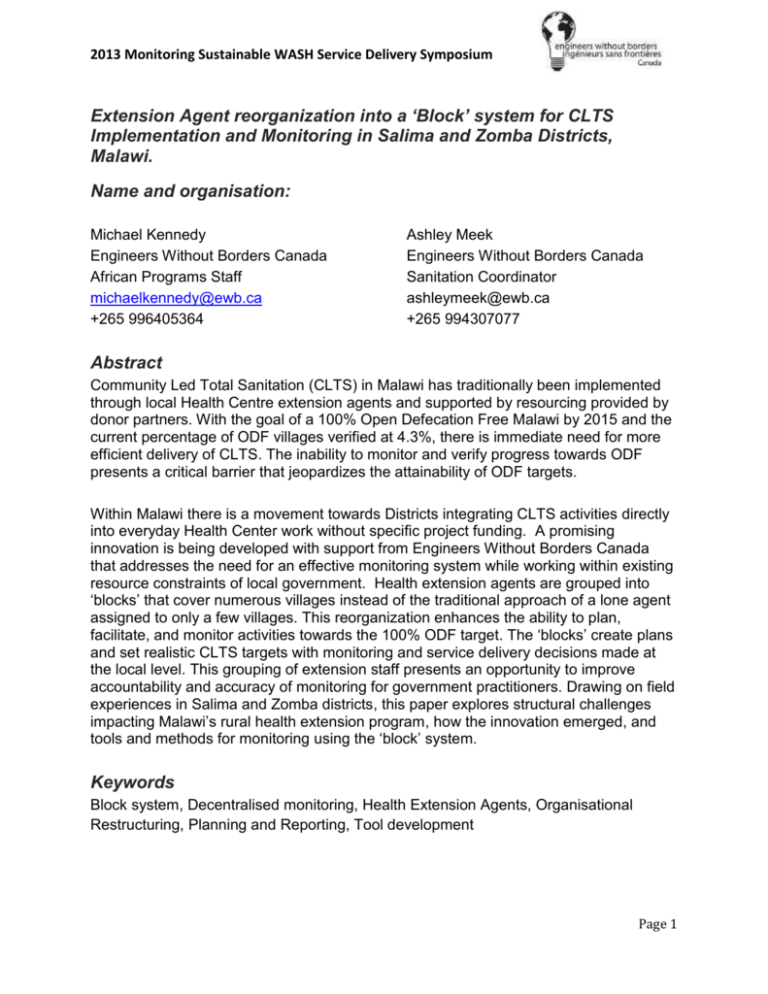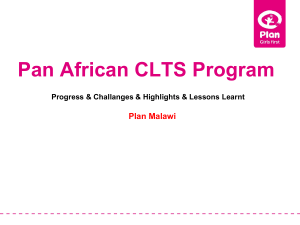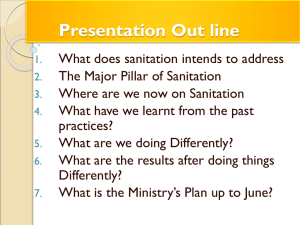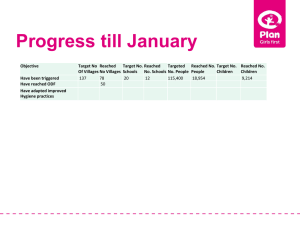the paper - Community
advertisement

2013 Monitoring Sustainable WASH Service Delivery Symposium Extension Agent reorganization into a ‘Block’ system for CLTS Implementation and Monitoring in Salima and Zomba Districts, Malawi. Name and organisation: Michael Kennedy Engineers Without Borders Canada African Programs Staff michaelkennedy@ewb.ca +265 996405364 Ashley Meek Engineers Without Borders Canada Sanitation Coordinator ashleymeek@ewb.ca +265 994307077 Abstract Community Led Total Sanitation (CLTS) in Malawi has traditionally been implemented through local Health Centre extension agents and supported by resourcing provided by donor partners. With the goal of a 100% Open Defecation Free Malawi by 2015 and the current percentage of ODF villages verified at 4.3%, there is immediate need for more efficient delivery of CLTS. The inability to monitor and verify progress towards ODF presents a critical barrier that jeopardizes the attainability of ODF targets. Within Malawi there is a movement towards Districts integrating CLTS activities directly into everyday Health Center work without specific project funding. A promising innovation is being developed with support from Engineers Without Borders Canada that addresses the need for an effective monitoring system while working within existing resource constraints of local government. Health extension agents are grouped into ‘blocks’ that cover numerous villages instead of the traditional approach of a lone agent assigned to only a few villages. This reorganization enhances the ability to plan, facilitate, and monitor activities towards the 100% ODF target. The ‘blocks’ create plans and set realistic CLTS targets with monitoring and service delivery decisions made at the local level. This grouping of extension staff presents an opportunity to improve accountability and accuracy of monitoring for government practitioners. Drawing on field experiences in Salima and Zomba districts, this paper explores structural challenges impacting Malawi’s rural health extension program, how the innovation emerged, and tools and methods for monitoring using the ‘block’ system. Keywords Block system, Decentralised monitoring, Health Extension Agents, Organisational Restructuring, Planning and Reporting, Tool development Page 1 2013 Monitoring Sustainable WASH Service Delivery Symposium Introduction Malawi has set an objective to reach 100% Open Defecation Free (ODF) status by 2015. To assist Districts in achieving this goal the National ODF Task Force has produced an ODF Malawi 2015 Strategy Document which prominently features CLTS as an implementation tool (ODF Task Force, 2011). During strategy dissemination, each District in Malawi was requested to create an individual action plan. As CLTS is one of the main activities outlined in the document many districts have included implementation as one of their main actions. The average ODF coverage in Malawian districts as of June 2012 is 4.3% (Environmental Health, 2012) making the 100% target extremely challenging to achieve if activities remain on the current trajectory. Historically CLTS activities have been heavily supported by and dependent on donor funding. However, with the magnitude of the challenge ahead alternatives to this methodology need to be explored. In 2011, Engineers Without Borders Canada (EWB), as a member of Malawi’s ODF Task Force, began researching the possibility of integrating CLTS implementation and monitoring into the regular portfolio of government rural health extension staff work. The goal of this work was for CLTS activities to be conducted without external funding, within the constraints (financial, transportation, human resource capacity, etc.) of the existing government rural environmental health program. To conduct this field work EWB partnered with Health Centres (HC) within the Districts of Salima and Zomba. Through a collaborative process it was observed that operational barriers with the organizational structure and management model of current extension staff were not conducive to efficient integration of new programs such as CLTS. The consequences of these barriers extend beyond CLTS activities and have implications that negatively impact the extension program as a whole – significantly hampering field level planning, monitoring and reporting. This discovery prompted an expansion in the scope of the original objective. An alternate service delivery model that grouped extension agents together to perform certain tasks was originally conceived and informally implemented by the Salima District Environmental Health Office. In partnership with both Salima and Zomba Districts EWB has been piloting methods to fundamentally change the configuration of the rural health extension program within the Health Centres into the so-called ‘Block’ system. This work includes organizational restructuring as well as the development and scaling of alternative methodologies for field level planning, administering and monitoring of extension activities. Iterative pilots in both Districts aim to increase the quality of Health Centre service delivery as a whole while simultaneously positioning the extension program to better integrate and monitor CLTS. Page 2 2013 Monitoring Sustainable WASH Service Delivery Symposium Context Malawi’s Rural Health Extension Program Malawi is divided into 28 districts, each equipped with an Environmental Health Office responsible for public hygiene and sanitation. Rural HCs are distributed throughout each district. Service catchment areas range from 15,000 to upwards of 100,000 people. The environmental health extension program operates through HCs and is administered by government extension staff - Health Surveillance Assistants (HSAs). AEHO Sr. HSA HSA HSA HSA HSA HSA HSA HSA HSA HSA HSA Figure 1: Traditional HC Management Structure An Assistant Environmental Health Officer (AEHO) oversees each HC’s extension program. They are responsible for managing the HC’s HSAs with the assistance of an assigned Senior HSA (in the event an AEHO has not been assigned to the health centre, the Sr. HSA is responsible for managing environmental health activities). Generally, each HSA is assigned between 1000 and 2000 villagers resulting in a typical catchment range of one to five villages. They are responsible for performing and reporting on all environmental health activities that occur within their catchment area. HSA responsibilities include immunization, newborn growth monitoring, sanitation infrastructure promotion, outreach clinics, tuberculosis (TB) patient follow-up, and other rural health issues. Integrating CLTS The introduction of CLTS to the HSAs’ portfolio has exposed several administrative challenges with this management structure. Although these challenges are discussed in terms of their impact on CLTS integration, they have implications for any new sanitation program Malawi wishes to scale through their HSAs. Barriers to successful integration of CLTS a) Training extension staff in CLTS Funding constraints limit the number of HSAs districts can train in CLTS facilitation. Typically, the catchment area of HSAs who have undertaken specialized training benefits from that training. Cross servicing is rare and typically those villages with untrained HSAs simply do not receive the same level of service. Because of the national focus on CLTS in Malawi, districts have been pressured to deviate from this method of service delivery and trigger all villages despite limited resources. CLTS trained HSAs Page 3 2013 Monitoring Sustainable WASH Service Delivery Symposium have been directed to form groups with untrained HSAs to facilitate CLTS in villages outside of their catchment area. A seemingly straight forward solution, this approach is laden with challenges and CLTS activities are stagnating as a result. - ‘CLTS group work’ is at odds with standardized planning and reporting typically undertaken by HSAs. Accustomed to planning and working individually; significant coordination challenges have emerged. - Transportation challenges (distance/availability/cost) limit the potential range of HSA influence. CLTS often does not occur until transportation (funded by the district or a partner NGO) is provided. This assisted transportation is typically accompanied by an allowance for ‘extenuating circumstances on the job’, perpetuating the notion that CLTS is outside the normal scope of HSA responsibility. - Allowances, provided to HSAs during CLTS training are being highlighted by untrained HSAs as an indication that they should not participate in any CLTS activities – having not participated in formal training and received the subsequent compensation. CLTS has been ‘projectized’ in these cases and is not viewed as part of the standard HSA portfolio. b) Prioritisation of CLTS Activities The integration of CLTS into the workload of HSAs has not been successful in many health centres. HSAs have been conditioned to plan as individuals. The capacity to meet as a group, determine an appropriate time to conduct CLTS activities and then integrate the group activities into their monthly program (and understand the implications of this on other activities) has not been readily observed. Moreover, these loosely formed groups have not been informed of how often they should conduct CLTS activities versus other work which significantly impacts target setting. c) Accountability There is no formal performance assessment of HSAs in Malawi. Advancement in position or pay is largely dependent on returning to school and obtaining accredited qualifications, not performing well. In addition to the relative lack of incentive to perform, expectations regarding frequency and quality of extension activities are typically not set. There is little in the way of positive or negative consequences for performing and regardless of this, formal performance indicators are not in place. The current atmosphere has significant impacts on CLTS. National level targets and goals have been set but there is little incentive for HSAs to meet these targets. There has also been relatively little done to assess and communicate the level of effort required at the HC level to meet targets. d) Monitoring and Evaluation HC level monitoring and reporting of field activities (including CLTS) is inconsistent. The vast majority of HCs administering CLTS are not actively tracking their work. For ODF verification and certification of a village to occur under the current system, an HSA Page 4 2013 Monitoring Sustainable WASH Service Delivery Symposium (responsible for that particular village) indicates to the district health office that the village is ready for verification. A group of District managers then visit the village for an inspection to officially declare the village ODF. The described process draws heavily on district time (including travel time a standard verification can take from half to a full day) and funds (districts do not often have a budget line for verification activities and are subject to outside support). If managers focus 20% of their time to CLTS verifications it will take most districts more than 15 years to reach complete ODF verifications. At the current rate verifications are occurring it will take Malawi over a century to verify and certify its villages as ODF. Block System Management Structure In an effort to support the integration of CLTS into the HSA portfolio, EWB and its district partners have been piloting an alternate management structure for the rural health extension program. This new model is an attempt to rectify challenges not addressed or resulting from the current management structure. The ultimate goal is to develop and establish an efficient system that is more conducive to adopting CLTS and similar programs in the long term. We refer to this structure as the ‘block’ system. AEHO Block 1 Block 2 (Sr. HSA; HSA; HSA) (HSA; HSA; HSA) Block 3 (HSA;HSA;HSA;HSA) Block 4 Block 5 (HSA; HSA;HSA;HSA) (HSA; HSA; HSA;HSA) Figure 2: Block System HC Management Structure In the block system, the AEHO remains responsible for the overall extension program at the health centre. As well, each HSA retains their assigned village(s). The planning and reporting of all activities however is done as a group (or block). Each block is comprised of four to five HSAs responsible for villages within geographic proximity to one another. In the event a task (such as a CLTS triggering) requires more than one HSA, they execute as a group. The remainder of their time is spent as before, servicing their assigned villages individually. The block creates a monthly work schedule that accounts for both group and individual activities. Methodology 1. District Partnership Design The process leading up to the Block system pilot took place in three stages. Page 5 2013 Monitoring Sustainable WASH Service Delivery Symposium Stage 1: CLTS Program Assessment EWB was stationed at three HCs in both Salima and Zomba. Through observation and interviews, the effectiveness of the CLTS program at each of the health centres was assessed. In parallel, the District administration of the CLTS program including funding and resource allocation, progress reporting and cross health centre knowledge sharing was identified and evaluated. The need for organisational restructuring within the HCs was identified and prioritized for the next stage of the design Stage 2: Service Model Intervention Design and Execution Challenges and leverage points observed during the initial assessment of the CLTS program were communicated to each respective district and informed the design of small scale pilot interventions. i. In Salima, an HSA grouping system was already in place at the HC. EWB focused on formalizing the Block structure, task prioritization, scheduling and progress reporting in two HCs ii. In Zomba, EWB focused on setting up Block groupings, scheduling and human resource coordination and trialed the implementation of a Block structure in two HCs Stage 3: Block System Support Materials for Monitoring – Design and Trial A second round of pilots was undertaken immediately following the initial trials. Informed by lessons learned in the previous pilots the second round focused on re-trialing the adoption of the block system, as well as trialing tools to help prioritize HSA tasks and planning as a block. 2. Monitoring and Evaluation using the Block System Drawing from national and international experiences with CLTS, rough level-of-effort requirements to support a village from triggering to ODF have been made. Based upon the assumption that each village requires one triggering and three to four formal followups before it is ready for ODF verification, health managers are able to perform generalized calculations to predict the number of CLTS activities each HSA block needs to conduct per month to reach their ODF target. This enables decentralized monitoring of CLTS activities and allows blocks to assess whether they are ‘on track’ with their CLTS activities. The frequency of these activities is reported alongside all other activities undertaken by the block. Tools for Management and Monitoring of CLTS activities A set of simple tools was co-developed with District and field staff to facilitate the organizational shift and assist with planning, monitoring and reporting of activities. Tools that have been developed which aid in the monitoring of CLTS activities are as follows: Page 6 2013 Monitoring Sustainable WASH Service Delivery Symposium 1. Calculation of CLTS activities In this exercise a rough activity number is calculated. The purpose is to provide a simplified guideline to HSA blocks so that they can track their CLTS activities. Unique cultural and topographic conditions within each Health Centre’s catchment area will impact the level of effort required for CLTS. By setting basic expectations regarding CLTS activities, extension staff are able to include CLTS in their regular planning and follow up on the expectations they have set to determine how reasonable they are. Each group must determine the number of total villages they will be responsible for. This number is multiplied by 4.5 CLTS activities per village (1 triggering and 3.5 followups1). This is then divided by the number of months remaining until the ODF target. The result is the total number of CLTS activities per month the group must perform. # of Villages Group A Group B Group C Group D Group E 17 11 10 4 15 X X X X X 1 Triggering and 3.5 Follow-ups per village 4.5 4.5 4.5 4.5 4.5 ÷ ÷ ÷ ÷ ÷ # of months until ODF target 23 23 23 23 23 = = = = = CLTS activities per month 3 to 4 2 2 1 3 Figure 3: Calculating Required CLTS Activities 2. Determining Workload Capacity and Expectations This Activity Planning tool includes consolidated task areas within a Health Centre for ease of management and reporting. The task areas have been divided into three categories: A- regularly occurring activities; B- response activities (e.g. Outbreaks, national campaigns, etc); and C- combined activities (activities with low time commitments that occur in conjunction with other activities). Managers plan for regular activities, leaving a buffer of 15% to 25% for uncertainties. The breakdown shown in Figure 4 was undertaken for a block of 5 HSAs. With each HSA working approximately 20 days a month, they have about 100 ‘working days’ between them. The group must then list all of their tasks / activities and assign them a category. For the category A – regular activities they complete the calculation section of the form. In this example 82 of their ‘days’ have been committed to regular activities. Activities for the additional 18 ‘days’ can be determined by the block. These extra ‘days’ provide buffer space to keep absences and unexpected events from stopping the group from meeting their monthly activities target 1 Note: In Malawi the verification step of CLTS is currently the responsibility of the District Council and not the HC. It is therefore excluded from the calculation Page 7 2013 Monitoring Sustainable WASH Service Delivery Symposium 3. Documenting a Work Schedule Referencing the HSA Activities Planning Tool completed for their group, a block will complete a schedule each month. As stationary shortages are a consistent setback in Malawi, this simple schedule can be completed by hand and uses one page of paper per group. The schedule includes activity and location for each HSA in the block. Activities that need to be completed in groups are filled in first and the remaining activities filled in where there are spaces left in the matrix. The Comments section will be filled in at the end of each week. In addition, any activities that are not carried out (such as the followup in Madalo village that Lucy and Charles planned to do as shown in Figure 5) are crossed out. This informs next month’s activities. Activities that did not go through as planned are considered when developing the next month’s schedule. Under this new system, field level reporting of CLTS activities is done alongside reporting of all other activities – there is next to no additional effort required of extension staff to report on CLTS. AEHO managers count the number of activities carried out by each block, add the numbers up and include the number in the health centre’s monthly activities report to the district. Page 8 2013 Monitoring Sustainable WASH Service Delivery Symposium Determine Workload Capacity Number of HSAs Days in a week x 5 Weeks in a month x 5 Workload Capacity = 4 100 Determine Expectations Only complete for Category A activities Office Work: Category C Task/Activity Areas Category B Category A Mark With X Number of HSAs conducting Activity? Number of Location(s)? Frequency per month (for one HSA for one location) 2 1 5 10 - - - - 1 4 16 X Nutrition; Malaria; Early Infant Diagnosis; Drug Distribution Patient Follow-up: X Palliative Care; Home-Based Care; TB Total HSAs x Locations x Frequency = Outreach Clinic: Immunization; Growth Monitoring; Family Planning; IEC X 4 CLTS X 5 X 5 1 4 20 VHR; Institutional Inspections; Disease Surveillance; School Health X 1 11 1 11 Water Testing X 1 11 1/3 4 x 1 11 1 11 - - - - Triggering; Follow-up Monday Meeting Number of OD Villages x 4.5 ÷ Number of months until target date 10 Data Collection/ Inspections: Testing; Chlorination VHC Activities: Training; Meetings Specialized Tasks: X Larva Spraying; HTC (HIV); etc Total Level of Effort Commitment 82 Figure 4: HSA Block Activities Planning Tool Blessings Ona Noel Lucy Charles Comments Activity Triggering Triggering Triggering Triggering Triggering Location Madalo Madalo Madalo Madalo Madalo High attendance at triggering – promising flames Activity Jiggers Follow up Jiggers Follow up CLTS Follow-up CLTS Follow-up CLTS Follow-up Location Madalo Madalo Chibwana Chibwana Chibwana Activity W. Chlorination W. Chlorination W. Chlorination W. Chlorination W. Chlorination Location Madalo Chisomo Chimwemwe Chimwemwe Malato Activity Outreach Clinic Outreach Clinic Outreach Clinic Outreach Clinic Outreach Clinic Location Madalo Madalo Madalo Chimwemwe Chimwemwe Activity Office Work Office Work Office Work CLTS Follow-up CLTS Follow-up Location HC HC HC Madalo Madalo Day M/16 T/17 W/18 Th/19 F/20 Jiggers at Madalo needs another follow-up. Unclean borehole at Chisomo, asked VHC to clean Lucy & Charles did not follow up because rain. Went to HC instead Figure 5: Example Block Work Schedule (one week) Page 9 2013 Monitoring Sustainable WASH Service Delivery Symposium 4. Visual Tracking at the Health Centre In addition to integrated reporting, some HCs have erected large sheets to publicly track CLTS activities. The matrix is completed by blocks on a village by village basis as CLTS activities are completed. Figure 6: Example Health Centre CLTS Tracking Poster Findings and Discussion Some of the key findings from using the Block System for monitoring are as follows: Streamlined training of HSAs By clustering HSAs into geographic blocks, HC managers are better able to evenly distribute training for programs such as CLTS. Working within limited budgets, managers are still able to train an adequate number of staff in CLTS by selecting a single HSA from each group for training and relying on group planning and execution to promote peer-to-peer learning and information exchange. In addition, because of geographic proximity, movement between villages within the block is possible. Page 10 2013 Monitoring Sustainable WASH Service Delivery Symposium Prioritizing CLTS Monitoring activities By planning their month as a unit, the integration of group and individual activities occurs relatively smoothly. The HSA blocks identify and plan their group activities (including CLTS) based on consensus and then work backwards to fill their remaining time with individual activities. Important to this process is that the block system allows managers to set workload expectations at the block level. Based upon the number of villages a block is responsible for, expectations regarding the number of CLTS activities to be conducted each month can be set – and the implications of this on other extension activities is made apparent. Accountability The block system promotes peer-to-peer accountability not previously present at the health centre. By working and planning as a group, HSAs commit to their block. When HSAs fail to complete their assigned tasks, their peers voice their concerns within the group or to a superior – streamlining supervision. Managers from pilot groups have unanimously championed the implementation of peer-to-peer accountability mechanisms; they are able to easily identify laggard HSAs, a relief to those HSAs that consistently perform well. Additionally, HSAs have reported enjoying the group planning and information sharing. Monitoring CLTS activities using the Block System The key to decentralized monitoring has been clear articulation of level of effort expectations. By making informed assumptions about program needs management is able to notify HSAs of how they should be spending their time. This allows for conscious balancing of activities and ensures tangible goals are set for CLTS. It also acts as a reference for HSAs when they create their monthly schedule and provides managers with the ability to quickly ensure blocks are distributing their time appropriately. There is infinite ambiguity in rural health; outbreaks, top-down national campaigns and the like impact HSA schedules on a monthly basis. These types of events will always impact HSAs’ ability to complete their planned activities. The utilization of these tools however provides an avenue to see how unexpected events impact progress on planned activities. In the case of CLTS for instance, a TB outbreak may drastically impact HSA schedules at a health centre, resulting in CLTS being dropped for a full month. Managers at that HC can see the direct impact of this outbreak on their planned programs. They have the information required at the field level to make a decision about increasing CLTS activities (at the expense of another program) or informing the district that an adjustment to the CLTS targets is required. Using a visual tracking tool blocks are able to compare progress and celebrate the emergence of ODF villages. While districts and national offices are primarily concerned Page 11 2013 Monitoring Sustainable WASH Service Delivery Symposium with tracking the execution of triggering and emergence of ODF villages, it is equally important for follow-ups to be tracked at the field level. Potential Risks Along with the benefits of the Block reorganization for monitoring some potential risks have also been identified. - Lowest common denominator effect: In group settings there is the potential for self governance toward improvement just as there is the opportunity to justify inaction and lowered performance results. - Negative competition between blocks and/or block members - Lack of group management resulting in blocks not creating their monthly plans or being held accountable to them - Over simplified tools resulting in misunderstandings or missed activities Another notable risk is a lack of group management resulting in blocks not creating their monthly plans or being held accountable to them. The system is designed to be championed by one person at the HC. Until the system is rolled out at a larger scale with the DEHO holding the HC accountable to reporting and by proxy planning, there is a risk of system breakdown if the responsible person leaves the HC or is unable to go to the HC for other reasons such as a transfer or fuel shortage. In these situations, the expectations in the HC were set but the follow-up planning and scheduling did not occur. These risks will continue to be evaluated and mitigated as the Block system and tools are rolled out. Next Steps for Monitoring in the Block System The tools and reporting templates have been trialed and iterated on in Salima and Zomba independently. Both districts have expressed interest in EWB’s continued support to assist with district-wide scaling of the block system and monitoring process. Over the coming months EWB will be preparing documents to support scaling of the block system and evaluating effectiveness of the tools i.e. determine actual impact on CLTS implementation activities over time. Next steps will include engaging with National partners to assess potential and prospects of block system, and determining what type of resourcing needs to be allotted to activities required for scaling. It is important to note that this system has been built on a series of incremental trials (failures), none of which has yielded field level evidenced based decision making. Page 12 2013 Monitoring Sustainable WASH Service Delivery Symposium Conclusions Monitoring at the local Health Centre level has primarily been done for reporting purposes and not for planning and evaluation. The ODF targets set by Malawi are very ambitious and in order for the districts and field level implementation staff to embody them in everyday work, assumptions need to be made to simplify expectations and clarify understanding. The Block reorganization allows HCs to determine priorities and better incorporate new activities, especially those like CLTS which require multiple extension agents in the same location at the same time to carry out the implementation. The tools have been created to enable managers and the individual Blocks to easily break down and simplify all of their responsibilities and show how they fit together in their provision of services. For CLTS activities they emphasise not only triggering but more importantly multiple follow-ups as essential to service delivery. The reorganization into Blocks and the planning, scheduling and reporting that this promotes has the potential as shown through the pilot Districts to dramatically improve not only CLTS implementation activity frequency and the number of ODF villages that result but also the Monitoring and Evaluation capacity of the individual Health Centres. References Environmental Health Office, 2012. Malawi WASH Monitoring and Evaluation June 2012 - Draft Report, Lilongwe: Ministry of Health. ODF Task Force, 2011. Open Defication Free (ODF) Malawi 2011-2015, Lilongwe: Government of Malawi. Page 13







